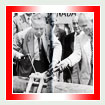|
Page 1 |
2 |
3 |
4 |
5 |
6 |
7 |
8

On June 10, the federal Board of Transport Commissioners, following public hearings, authorized Interprovincial to build its 16-inch, 450-mile pipeline from Edmonton to Regina.
Long before the authorization had been received, before Interprovincial had even been incorporated, Imperial Oil had taken the first step to build the line: obtaining the necessary pipe.
Imperial first started looking for a supply of pipe in 1948, in the hope that the line to Regina could be built the following year. The task of finding 450 miles of pipe was not easy. No pipe mills in the United States could deliver in time, and in Canada there were no pipe mills. Page-Hersey Tubes Ltd., was prepared to build Canada's first pipe mill, a $5-million plant at Weiland, Ontario, but there was yet another problem, a supply of the special steel plate required to make the pipe. Finally, with some help from federal Trade and Commerce Minister C.D. Howe, Imperial was able to complete arrangements in December to import some 40,000 tons of steel plate from Britain. This steel would not meet the specifications for making the pipe, but it would meet some of the customer requirements of the Steel Company of Canada, thereby freeing capacity in Stelco's Hamilton plants to make the specification plate from which Page-Hersey could roll the pipe.
By mid-1949 the problems appeared to have been met to allow construction of the line to Regina the following year. Imperial Oil had obtained, by special act of Parliament, a charter for a pipeline company; the Board of Transport Commissioners had authorized construction of the line; Stelco was preparing to roll the steel plate, and Page-Hersey was building Canada's first pipe mill.
There were further complications. Even while it was proceeding with the plans for a 450-mile line to Regina, Imperial had its engineering group in Tulsa working on design and feasibility studies of a much longer system from Edmonton to the head of Lake Superior. From this point, the crude could be moved by tanker during the summer shipping season to refineries at Sarnia. The rapidly growing oil reserves in Alberta, with the attendant requirement for larger market outlets, appeared to make the longer line feasible. "Extension of the Edmonton-Regina pipeline to the head of the lake in the near future is a development which Imperial Oil is actively pursuing," Imperial chairman H.H. Hewetson stated in May in an address to the Regina Chamber of Commerce.6
By that summer, Imperial had decided on construction of the longer pipeline system, had selected a route 1,140 miles from Edmonton to Superior, Wisconsin, and had completed the preliminary design and engineering studies. In August, Lakehead Pipe Line Company Inc., was incorporated as a wholly-owned U.S. subsidiary of Interprovincial to construct and operate the portion of the pipeline system in the United States. In September, application was made to extend the planned system from Regina to Gretna on the Manitoba-U.S. border; the section from Gretna to Superior would be handled by Lakehead Pipe Line. The application was quickly approved by the Board of Transport Commissioners.
[Next>>]
|
 Heritage Community Foundation Presents
Heritage Community Foundation Presents


 Heritage Community Foundation Presents
Heritage Community Foundation Presents